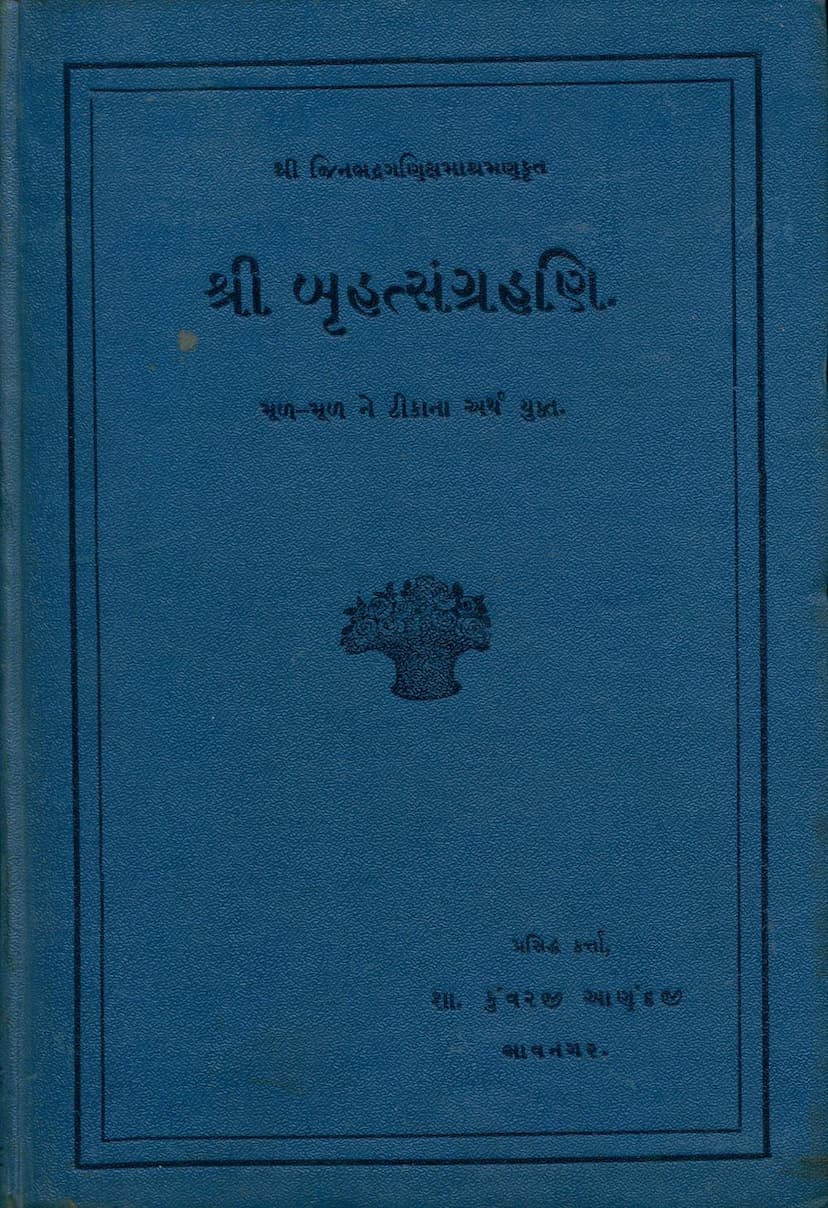Bruhat Sangrahani
Added to library: September 1, 2025

Summary
The provided text is a Gujarati translation of the Jain text "Bruhat Sangrahani" by Jinbhadra Gani, with a commentary by Malayagiri. The text is a comprehensive astronomical and cosmological treatise within Jainism, detailing the nature and characteristics of celestial beings and the structure of the universe.
Here's a breakdown of the content based on the provided pages:
Overall Purpose:
The "Bruhat Sangrahani," also known as "Trailokyadeepika" (Lamp of the Three Worlds), is a detailed explanation of the Jain cosmology. It describes the beings in the three worlds (heavens, hells, and the middle realm of humans and animals) and their respective characteristics.
Key Themes and Content:
- Authorship and Commentary: The text is authored by Jinbhadra Gani Kshamashramana and features a commentary by Malayagiri. The translation and publication were facilitated by Kunvarji Anandji.
- Structure of the Universe: The book is named "Sangrahani" because it collects and summarizes information from various scriptures like Prajnapana Sutra. It covers the beings in the three realms:
- Devas (Gods): A significant portion of the text is dedicated to devas, detailing their:
- Lifespans (Ayushya): Discussing minimum and maximum durations in various celestial abodes (Vaimānika, Bhavanapati, Vyantara, Jyotishi).
- Realms and Abodes (Bhavana): Describing the various heavens and palaces where devas reside.
- Types of Devas: Categorizing them into Bhavanapati (dwellers of palaces), Vyantara (intermediate beings), Jyotishi (celestial bodies like sun, moon, stars), and Vaimānika (dwellers of palaces in the upper heavens).
- Hierarchical Structure: Explaining the different ranks of devas, including Indras (kings), Samanika (ministers), Parshada (councillors), etc.
- Physical Attributes: Discussing their forms, colors, signs, and the nature of their bodies.
- Cessation of Life (Chyavana): Describing where devas are reborn after their lifespan ends.
- Sensory Experiences and Happiness: Mentioning their modes of sustenance and their unparalleled bliss.
- Narakis (Inhabitants of Hells): Detailing the seven hellish realms, including:
- Lifespans: The duration of suffering in each hell.
- Realms (Pṛthvi): The distinct types of hellish earth.
- Pain and Suffering: Describing the intense physical and mental anguish experienced by the Naraka beings.
- Dwellings (Naraka-avasas): The structure and types of hellish abodes.
- Lashyas (Psychic Dispositions): Explaining the predominant psychic states in each hell.
- Tiryanches (Animals/Sub-humans) and Humans: While the focus is heavily on devas and narakis, the text also touches upon:
- Lifespans and Bodies: Mentioning the lifespans and physical forms of various beings.
- Bodily Forms: Describing the characteristics of different types of beings.
- Origin and Rebirth: Discussing where beings from different realms are reborn.
- Cosmic Elements: The text also includes descriptions of:
- Planets, Stars, and Celestial Movements: Discussing the number, positions, and movements of celestial bodies.
- Islands and Oceans: Detailing the structure of the various continents and oceans in the Jain universe.
- Dimensions and Measurements: Providing specific measurements in yojanas and angulas for various cosmic entities and beings.
- Devas (Gods): A significant portion of the text is dedicated to devas, detailing their:
- Introduction and Mangalacharan: The text begins with invocations to Lord Vir (the last Tirthankara) and the author, Jinbhadra Gani, as is customary in Indian philosophical and religious works. It also explains the importance of stating the "Anubandha Chatushtaya" (four introductory elements: subject matter, purpose, relation, and audience) before commencing a text.
- Detailed Tables and Diagrams (Yantras): The text references numerous "yantras" (diagrams or tables) to illustrate complex cosmological data, such as lifespans, numbers of beings, and sizes of realms. The table of contents lists many such yantras.
- Philosophical and Doctrinal Points: The text implicitly or explicitly addresses Jain philosophical concepts like karma, rebirth, and the nature of souls (jivas) through its descriptions.
Key Sections Mentioned in the Table of Contents (and implied by the text):
The detailed table of contents (starting from page 8) reveals the meticulous organization of the "Bruhat Sangrahani." It covers numerous "dwaras" (gates or topics), including:
- Meaning of words like "Sura" (deva) and "Naraka."
- The "nine doors" (Ayushya, Bhavan, Avagahana, Upapat-virahakal, Udvarta-virahakal, Upapat-sankhya, Udvarta-sankhya, Gati, Agati) for devas and narakis, and "eight doors" for humans and animals.
- Detailed explanations of various celestial realms (Sodharma, Ishana, Sanatkumara, etc.) and their respective lifespans.
- The number and types of celestial vehicles (Vimana).
- The astronomical details of the sun, moon, stars, and planets.
- The nature of hellish realms, including their specific tortures and inhabitants.
- The characteristics of various types of beings like Nagakumara, Vidyutkumara, Yaksas, Gandharvas, etc.
- The concept of "Palyopama" and "Sagaropama" for measuring time.
- Detailed descriptions of the physical characteristics and classifications of devas and narakis.
- The intricacies of celestial regions, continents (Dvipas), and oceans (Samudras).
- Discussions on the creation and formation of the universe.
Publication Details:
- Publisher: Kunvarji Anandji (Shri Jain Dharma Prasar Sabha, Bhavnagar).
- Published in Vikram Samvat 1991 (corresponding to Veer Samvat 2461).
- The preface mentions the inspiration from Guruji Labhashriji and financial support from the Shravika varga (female lay followers).
- The translation was done by Sha. Kunvarji Anandji, with research and editing by Nyayasri Dana Vijayji.
In essence, "Bruhat Sangrahani" is a foundational Jain text for understanding the vast and intricate cosmology of Jainism, providing a detailed framework for the structure of the universe and the beings that inhabit it. The Gujarati translation aims to make this complex knowledge accessible to a wider audience.